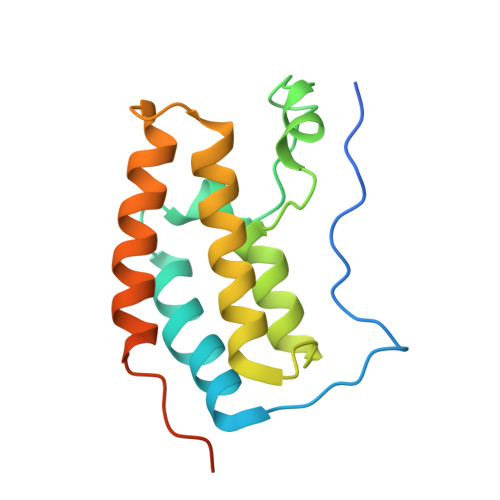Bet Inhibition Silences Expression of Mycn and Bcl2 and Induces Cytotoxicity in Neuroblastoma Tumor Models.
Wyce, A., Ganji, G., Smitheman, K.N., Chung, C., Korenchuk, S., Bai, Y., Barbash, O., Le, B., Craggs, P.D., Mccabe, M.T., Kennedy-Wilson, K.M., Sanchez, L.V., Gosmini, R.L., Parr, N., Mchugh, C.F., Dhanak, D., Prinjha, R.K., Auger, K.R., Tummino, P.J.(2013) PLoS One 8: 72967
- PubMed: 24009722
- DOI: https://doi.org/10.1371/journal.pone.0072967
- Primary Citation of Related Structures:
4BJX - PubMed Abstract:
BET family proteins are epigenetic regulators known to control expression of genes involved in cell growth and oncogenesis. Selective inhibitors of BET proteins exhibit potent anti-proliferative activity in a number of hematologic cancer models, in part through suppression of the MYC oncogene and downstream Myc-driven pathways. However, little is currently known about the activity of BET inhibitors in solid tumor models, and whether down-regulation of MYC family genes contributes to sensitivity. Here we provide evidence for potent BET inhibitor activity in neuroblastoma, a pediatric solid tumor associated with a high frequency of MYCN amplifications. We treated a panel of neuroblastoma cell lines with a novel small molecule inhibitor of BET proteins, GSK1324726A (I-BET726), and observed potent growth inhibition and cytotoxicity in most cell lines irrespective of MYCN copy number or expression level. Gene expression analyses in neuroblastoma cell lines suggest a role of BET inhibition in apoptosis, signaling, and N-Myc-driven pathways, including the direct suppression of BCL2 and MYCN. Reversal of MYCN or BCL2 suppression reduces the potency of I-BET726-induced cytotoxicity in a cell line-specific manner; however, neither factor fully accounts for I-BET726 sensitivity. Oral administration of I-BET726 to mouse xenograft models of human neuroblastoma results in tumor growth inhibition and down-regulation MYCN and BCL2 expression, suggesting a potential role for these genes in tumor growth. Taken together, our data highlight the potential of BET inhibitors as novel therapeutics for neuroblastoma, and suggest that sensitivity is driven by pleiotropic effects on cell growth and apoptotic pathways in a context-specific manner.
Organizational Affiliation:
Cancer Epigenetics Discovery Performance Unit, GlaxoSmithKline, Collegeville, Pennsylvania, USA.















